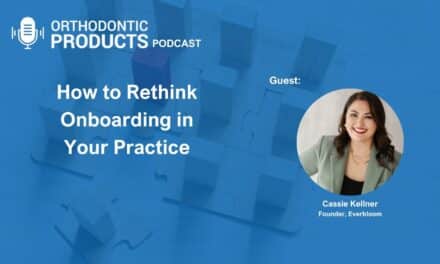Summary: In this episode of the Orthodontic Products podcast, Leon Klempner, DDS, CEO of People + Practice, shares strategies for launching a successful orthodontic startup. He emphasizes building awareness, establishing credibility, and creating a differentiated brand through messaging, effective websites, and targeted digital marketing. These foundational steps ensure practices attract and convert patients quickly.
Key Takeaways:
- A clear unique value proposition is essential for differentiation and credibility.
- Pre-launch preparation, including SEO-ready websites and social media presence, accelerates growth.
Starting an orthodontic practice is an exciting milestone but comes with unique challenges—especially when it comes to marketing. In the latest episode of the Orthodontic Products podcast, host Alison Werner is joined by Leon Klempner, DDS, chief executive officer of People + Practice and host of The Golden Age of Orthodontics podcast. With 38 years as an orthodontist and expertise in marketing, Klempner shares essential strategies for creating awareness and credibility in your community as you open your doors.
This is the first of a three-episode series exploring how orthodontic practices can tailor their marketing strategies during different transition phases, from startups to mid-career growth, to preparing for exit.
The Essentials of Startup Marketing
Klempner emphasizes that marketing for a startup boils down to two critical goals: building awareness and establishing credibility. Gone are the days when a practice could organically grow its reputation over years. Today, new practices must quickly and strategically create a strong presence to compete effectively.
To achieve this, Klempner suggests prioritizing foundational elements:
- Define Your Unique Value Proposition (UVP): What makes your practice stand out? This differentiation lies at the intersection of community needs, what your practice can consistently deliver, and what competitors are not doing.
- Develop Messaging and Branding: Your messaging must align with your UVP and inform everything—from your logo to your website and social media presence.
The Power of Pre-Launch Planning
According to Klempner, preparation is critical. Before spending on advertisements or launching a website, practices must solidify their brand identity. This involves creating a messaging document to serve as a “North Star” for all marketing efforts.
He explains how a website should function as a conversion tool—not just a digital brochure. With features like seamless user interfaces, built-in SEO, and online scheduling tools, your site should drive potential patients to book consultations. Additionally, maintaining consistent information across digital properties is vital for visibility and trust.
Digital Strategies for Modern Audiences
Marketing to “digital native” parents requires being present where they are—on platforms like Facebook and Instagram. Klempner highlights the importance of educational ads and Google paid ads to capture attention and convert interest into appointments. Moreover, leveraging tools like HIPAA-compliant chat portals can ease barriers for prospective patients by enabling quick communication without high commitment.
Tune in for More
This episode provides a roadmap for marketing a successful orthodontic practice, from setting up digital real estate to establishing trust in your community. Next week, the series will delve into marketing strategies for mid-career orthodontists transitioning their practices.
Catch the full episode to hear more insights from Dr Klempner on mastering orthodontic marketing at every stage of a career.
Podcast Transcript
Alison Werner (00:10)
Hello and welcome to the Orthodontic products podcast. I’m your host, Alison Werner. Over the next three episodes, we’re going to talk about practice transitions, specifically how your marketing strategy should differ depending on whether you’re a startup practice at the midpoint and bringing on a new associate or partner or getting ready to exit. And joining me to do this is Dr. Leon Klempner, co-founder of People + Practice an orthodontic marketing agency and host of the Golden Age of Orthodontics podcast.
I’m excited to have Dr. Klempner for this series because he not only brings his expertise in practice marketing, but also his 38 years of experience as an orthodontist in private practice to this conversation. So in this episode, episode one, we’re going to focus on that beginning stage, that point in time when you are ready to open the doors to your first private practice. We’re going to talk about the importance of defining unique value propositions, effective messaging, and community launch strategies.
Dr. Klempner, thank you for joining me.
Dr. Klempner (01:07)
Thanks, Alison. Appreciate it.
Alison Werner (01:09)
Okay, so let’s get started. Are there specific considerations you take into account when you are talking with a practices just starting out?
Dr. Klempner (01:20)
yeah, there are, but…
The truth of the matter is that regardless of what stage in ortho practice is in, from a marketing perspective, are basically three critical things that you need to take into consideration. One is, what are the milestones during this stage and what do we need to prepare for it? What are the strategies in order to capitalize on the event from a marketing perspective as well as mitigating some of the risks? And number three, what time
type of marketing do we need to make this whole thing happen? So this is true regardless of whether you’re starting from scratch, whether you’re in the mid-stage of your career, bringing on an associate or a partner, opening a satellite office, purchasing an additional location. It doesn’t really matter. We have to pay attention to all of these milestones and prepare for them.
Alison Werner (02:18)
Okay, so then how is that specific for a startup?
Dr. Klempner (02:23)
Well, startups have their own priorities. And basically, it’s pretty straightforward. For a startup, whether you’re buying a practice, somebody else’s practice, or you’re building your own from scratch, the strategy basically is twofold. Number one,
We need to build awareness of your practice, your brand, of you in the community. And number two, we need to establish some credibility. It used to be that you would open up an office and you would kind of develop your brand and your name in the community over a period of time.
Sometimes it would take years before your name would be one of those names that moms would talk about at the soccer field or at the bus stop. That’s all changed now. You could come onto the scene very, very strongly now. And we’ve seen this in many areas where well-established practices that are not kind of paying attention to the change of marketplace and the digital natives that they’re targeting. And somebody young comes in and spends some money with a
marketing company and before you know it, you know they take market share. awareness and credibility.
Alison Werner (03:43)
Okay, so you mentioned there the need to have a plan. So how do you prepare that plan and what’s involved?
Dr. Klempner (03:50)
So Alison, that’s our secret sauce. to be, well, let’s put it this way. It’s so not well understood, but foundational to any practice’s success, that I’m gonna outline it for you and share it with you. So the key is, before you do anything,
Before you spend money on a website, on marketing Facebook or advertising, before you do any of that, you need to establish a differentiated value. In marketing, they call it a value proposition. So before you tell anybody anything, you need to figure out who you are and what you’re bringing to the table. So we have a process of doing this with our clients.
Alison Werner (04:31)
Okay.
Dr. Klempner (04:43)
My partner Amy has got a lot of expertise in drawing this out. But just to simplify it, basically what we want to do is we want to differentiate ourselves. Marketing is about differentiation. So what is unique about the practice? And what we do is if you think about a Venn diagram with three circles, in one circle, what do the patients in your community want?
That’s relatively easy, but it varies depending on the demographic. The second circle is what can you…
consistently deliver. And that’s really the key. A lot of practices feel that, well, we’re great on technology. And if they put that out there and patients come in and they see a practice that looks like it came from the 70s, then it backfires on you. So you need to really deliver on what you’re claiming to deliver consistently. And number three, and this is the one probably most misunderstood, is what
Alison Werner (05:39)
Yeah.
Dr. Klempner (05:50)
What is the competition not doing?
Whether whatever they are doing, if they’re not putting it out into the community, that’s an open lane. That’s like, you know, in football, that’s like your front line opening up the spot for you to come right down the middle. So it’s the triangulation of those three circles. You know, what the patients want, what you can deliver and what the competition is not doing. And that center part of it, that center part of the Venn diagram, that’s the differentiator.
Alison Werner (05:54)
Okay.
Dr. Klempner (06:24)
And from that, we develop a messaging document. And this is kind of the North Star of everything. That’s the most important element, and it’s the most commonly misunderstood or not paid attention to.
It’s almost like having an elevator message for your staff and your team to constantly repeat. And then only from then and only after doing this exercise do you move to a logo development which should reflect your value proposition so that your logo isn’t just something that looks pretty and the color is nice but actually has meaning in terms of what your practice stands for.
Alison Werner (06:59)
you
Dr. Klempner (07:11)
And then the website, which should also reflect this identity and act as a conversion machine for new patient consults. And all of the social properties, Facebook page, Instagram, everything needs to highlight your North Star. And then from there, we launch it to the community, put some advertising dollars behind it, and that’s how you get off the ground.
Alison Werner (07:39)
So earlier you mentioned that there is a difference between the purchase of a practice and a scratch startup. But what are they?
Dr. Klempner (07:48)
Okay, well, as I mentioned before, when you’re starting out, it’s awareness and credibility.
The community doesn’t know who you are. And we need to establish that. And we need to establish it pretty quickly. So you want to do things like getting your Google business page set up early so that Google could find you in terms of location. So you want to do that right off the bat. Establishing an online presence is really key so that when you’re opening your doors, you’re not just starting.
Ideally, you already have people that are wanting to schedule appointments with you. So you have a head start in terms of what’s going on. So getting the marketing out before you open the doors is really critical for the startup. When you purchase the practice, that’s a little bit different. Because when you purchase the practice, what are you purchasing? You’re purchasing the charts, for sure, but you’re really buying the goodwill. And we need to nurture that.
So we need to create the ability to transfer that trust and credibility from the doctor who’s leaving to you. Otherwise, we lose all of that. So this means communication. So this is part of a marketing strategy. It’s not the traditional transactional Facebook ad or Google ad, but it’s so critical to the success of the buyer to have the seller transfer that
that trust over. So my partner Amy Epstein has a lot of expertise in this area and we actually have a communication package that we work with and customize depending. So you need to communicate what’s going on in the purchase to all the stakeholders, to the staff, to the referring doctors, to their patients in the practice and to the community. And it’s got to be done in that order.
This is really critical because I’ll give you an example from my own practice. As an orthodontist, we don’t really refer to other specialists that much. Once in a while to perio, but primarily to oral surgery, extractions, surgical cases, things like that. And you have a trust and a relationship with a colleague.
Alison Werner (09:54)
Yeah.
Mm.
Dr. Klempner (10:13)
In this case, it’ll be an oral surgeon. And I remember one time I referred one of my adults and I got a letter back from I don’t know who. It was an associate that they had hired, but I didn’t know this and it was a little bit annoying to me and offsetting to me because I’m…
Alison Werner (10:25)
Okay.
Mm.
Dr. Klempner (10:32)
transferring the trust to the patient. The patient’s relying on me to make that referral. Now, if I’m not in the loop, so to speak, and I’m hearing it from my patient, that’s not good. So the way it’s communicated, the order it’s communicated, everything has to be really thought out carefully and executed in order to be successful. In addition to all of that, there are some basic
Alison Werner (10:42)
Yeah.
Dr. Klempner (11:02)
real estate things that need to be in place. I’ll take a minute just to share that with you because it’s so important. Because everybody jumps to website and Facebook ads, but the messaging has to come first. But once that’s in place, you do need a website. And believe it or not, 97 % of people that go to orthodontic websites never schedule a consult.
Alison Werner (11:05)
Yeah, please do.
Mm-hmm.
Okay.
Dr. Klempner (11:25)
They come, they look, they leave. That’s no good. The purpose of a website should be to convert to a consultation. So, and there are a lot of reasons for that. There’s the user experience, there’s the interface, it needs to be set up properly. You need to have SEO.
Alison Werner (11:28)
Okay.
Dr. Klempner (11:43)
on page and off page. This is often misunderstood. know, it does you no good to spend a lot of money on SEO if your website isn’t properly prepared for it. So there’s a back end to websites.
Alison Werner (11:57)
Okay.
Dr. Klempner (11:57)
And they have meta tags, they have descriptions, there’s layouts, there’s relevant keywords, all sorts of things that need to be in place for a website to function properly and be seen by the Google bots, that if you don’t have it in place, you’re just wasting all of your money and spending on external.
Alison Werner (12:00)
Mm-hmm.
Dr. Klempner (12:20)
off page SEO, things like that. But you do have to pay attention to off page SEO. That means things like name, address, phone number, back links, Google page. I don’t want to get, this isn’t the time to go over that, but I’m certainly available to discuss it. But there’s so many things that need to be in place in order to be successful.
Alison Werner (12:23)
Okay.
Yeah. Yeah.
Alison Werner (12:44)
So I’m just wondering what types of digital properties or kind of that real estate should a startup practice have in place?
Dr. Klempner (12:52)
Well, mean, there are some basics that are obvious that need to be in place. And this is regardless of really what stage, but particularly important for a startup. So as I said before, the messaging comes first. But once you have the messaging, you have the logo development, now it’s time to build out the website.
Now, unfortunately, statistics show that 97 % of visitors to orthodontic websites never convert to a consultation. They look, they read, they move on. So that’s not really…
great for us. We need to change that. And some of the reasons for that have to do with things like user interface and user experience, how fast it loads, certainly how it’s built out. For example, SEO, where most people think about SEO as something that you kind of work on separate from the website. But
SEO has to be part of the website. So there’s what’s called on-page SEO, which means that it’s part of the back end of the website build itself. These are things like optimizing the titles, meta and descriptive tags, the site layout.
relevant keywords, content, all of this really has to be built into the website right from the beginning. From there, you could look at off-page factors for SEO, like name, address, phone number. This is so critical.
Alison Werner (14:28)
Mm-hmm.
Dr. Klempner (14:38)
Believe it or not, having a comma in Boulevard or spelling out Boulevard or having a period and not having a period at the end of Avenue or spelling out Avenue, this stuff confuses the box. They’re looking for consistency. So just cleaning those up.
Alison Werner (14:50)
Okay.
Dr. Klempner (14:58)
Making sure that they’re the same on all of your properties goes a long way to enabling you to be seen. those are critical areas. But in addition to that, there are things that are related to your Google business page. There are some backlinks that could be developed for authority. There’s a lot that could be done. This isn’t kind of the time and place to discuss it, but if you want to DM me on Facebook or contact me, can.
go into more detail. But in addition to that, the obvious things, meta. We’re dealing with digital natives now. You know, I used to think of digital natives as teenagers. Digital natives are moms. They’re our target right now. So we need to be where they are. And moms are still on Facebook. They’re on Instagram, too. We need to be there. But we need to be where they are. So Facebook, Instagram, these are ideal for
Alison Werner (15:36)
Yeah.
Yeah.
Okay.
Dr. Klempner (15:58)
awareness ads for if you’re a new practice in the community this is a great place for you to let them know that you’re here and that you’re available and what you do. There’s also traffic ads that you can do, educational ads that you can do. You know I get a lot of questions and sometimes resistance from some of mature orthodontists that call me that you know they don’t want to be that showy. They’re not
Alison Werner (16:27)
Mm-hmm, right. Right.
Dr. Klempner (16:27)
looking to do, you know, TikTok dances and you know, mean, those things are great and they do show if you have the personality and your practice is such, that’s great. But if you don’t, you don’t have to do all of these things. There are other things that that you can do to establish, you know, an organic social presence and show off what your practice is about. But there are also things that that are important for those that are a little further down.
Alison Werner (16:36)
Mm-hmm.
Yeah. Right.
Dr. Klempner (16:57)
the funnel in terms of being actively looking for an orthodontist. This is where Google comes into play. So Google paid ads. This is where when somebody types in orthodontist in your community, that you show up. So you may not have the teeth and the content to show up well when you’re first starting out, but you can buy your way in there. You could show up.
Alison Werner (17:13)
Yeah.
night.
Dr. Klempner (17:25)
just by paying some money to Google so that at least your name comes up. And as I said, we’re dealing with digital natives. So I can’t tell you how many times I see practices that have medical forms and informed consent in a PDF form and are expecting a digital native to download it, print it, fill it out by hand.
Alison Werner (17:30)
Mm-hmm.
Right? Mm-hmm.
Dr. Klempner (17:52)
when their competitors have online forms, quick, simple, easy. It reflects on your practice. People make decisions about the quality of care and how up to date you are by something as simple as that. And there’s also, this is interesting, because I never knew this, there’s the ability to remarket. People that come to your website and then,
Alison Werner (17:58)
Mm-hmm.
Yeah.
Dr. Klempner (18:17)
go somewhere else. You know how sometimes you go on Amazon, let’s say, and you put something in the cart? And then two days later, hey, did you forget this? How did they know that? Well, there are ways that, with pixels and variety of things that are beyond my pay scale, that you could put some dollars behind and revisit this. So there’s a lot that needs to be in place.
Alison Werner (18:22)
Mm-hmm. Yeah.
Right, yes. Right.
Dr. Klempner (18:45)
but it’s not transactional. Everything has to be in place so that it’s more harmonious and at least has that strong messaging and differentiation throughout all of the properties.
Alison Werner (19:04)
What are your thoughts on you mentioned there that having a website like not having a PDF form and that it you know that doesn’t reflect on being if you’re gonna say you’re technologically advanced in your marketing language and then you’re using a PDF that doesn’t exactly lend that credence that credibility. What are your thoughts on those kind of chat features on the websites to engage with people who do visit your site as a way to keep that relationship going to keep them on
the site.
Dr. Klempner (19:35)
The concept is great, the execution sometimes isn’t, it depends.
Alison Werner (19:39)
Yeah.
Leon (19:42)
give a little plug to People + Practice. We’ve developed our own new patient portal, called PatientQ, that has tech this built into it. And the advantage of having a way of quickly communicating with new patients is that they’re not current patients yet. So they’re not in your practice management system. So you don’t have that access. Even if you have texting in your practice management system, these are just lookers. They’re kicking the tires.
Alison Werner (19:47)
okay. Okay. Okay.
Right.
Mm-hmm.
Dr. Klempner (20:11)
but they may have some valid questions. And having the ability to engage with them without them having to commit to scheduling an appointment, coming in.
Alison Werner (20:22)
or just making a phone call.
Dr. Klempner (20:24)
or just making a phone call. And you know, the advantage of having a portal where you can have all of this information and having a HIPAA compliant way of communicating back and forth where, for example, a patient could…
share a copy of their insurance card and send it off. And you can have that checked if they’re concerned before their scheduling whether their insurance is going to cover or not. So there are different barriers that you can eliminate by having a quick and easy chat without a big commitment. That’s the thing. They’re not willing to give you their name. That’s the thing about the chat. Some of the chats that I’m concerned about is they ask for like your social security number and all
Alison Werner (20:52)
Right?
Yeah.
Dr. Klempner (21:14)
of this stuff, they’re not willing to do that. They’re not committed yet. They’re just in the early stages, but they’re interested because they’re on your property. So you want to nurture that along and a good HIPAA compliant way of doing that via chat is a good way of doing that.
Alison Werner (21:19)
Right.
Mm-hmm. Mm-hmm.
Great.
Alison Werner (21:35)
Well, Dr. Klempner, thank you so much for especially bringing up some of those finer details that I’m sure people are missing. So we will be back next week with our next episode in this series. And we’re going to talk about kind of that mid-career practice and how they deal with the transition, such as bringing in an associate or bringing on a new partner. So Dr. Klempner, thank you again. We’ll see you next time.
Dr. Klempner (21:58)
Thank you.













